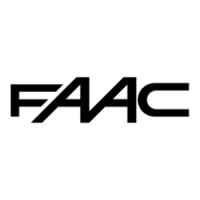
Do you have a question about the FAAC 578D and is the answer not in the manual?
| Operating Voltage | 24 Vdc |
|---|---|
| Protection Class | I |
| Protection Degree | IP54 |
| Temperature Range | -20°C to +55°C |
| Inputs | Open, Close, Stop, Safety devices in opening, Safety devices in closing |
Essential safety obligations for installers, covering general precautions and product use.
Crucial safety advice before performing any work on the control board.
Requirement for installing a differential thermal breaker for system safety.
Instructions for connecting the earth cable to the J7 connector.
Advice on separating power cables from control/safety cables to prevent electrical noise.
Description of the DL signalling and programming display unit.
Explanation of the LED status for input control.
Details of the J1 terminal board for low voltage connections.
Information on the J2 connector for various receivers.
Details of the J7 terminal board for motor and lamp connections.
Information about the F1 fuse for motor and transformer.
Details on the F2 fuse for low voltage and accessories.
Description of the 'F', '-', and '+' programming push-buttons.
Function of opening safety devices during gate opening.
Function of closing safety devices during gate closing.
Function of opening/closing safety devices during both movements.
Function of edge safety devices during gate movements.
Function of the encoder as an obstacle detection device.
Note on anti-crushing function for industrial sectional doors during closing.
Advice on connecting multiple safety devices with the same function in series.
Instructions for jumpering terminals when safety devices are not used.
Reference to diagrams showing common photocell and safety device configurations.
Description of the PE terminal for earth connection.
Description of the N terminal for neutral power supply.
Description of the L terminal for line power supply.
Note on the importance of connecting the earth conductor for correct operation.
Details on connecting the motor to terminals 17-18-19.
Information about the flashing lamp output at terminals 20-21.
Directive to consult tables for logic operations on the J1 terminal.
Description of the OPEN A command input on terminal 1.
Description of the OPEN B command input on terminal 2.
Explanation of the FSWOP opening safety devices input on terminal 3.
Explanation of the FSW CL closing safety devices input on terminal 4.
Description of the STOP input on terminal 5 for stopping gate movement.
Description of the SAFE edge safety device input on terminal 6.
Explanation of FC1/FC2 limit-switch inputs on terminals 7 and 8.
Description of the ENCODER input on terminal 9 for motor rotation control.
Details on negative power supply for accessories on terminals 10, 11, 12.
Details on positive power supply for accessories on terminals 13, 14.
Description of TX-FSW terminal for photocell transmitter power supply.
How to connect indicator lights, timed exits, or other devices to terminal W.L.
Use of the J2 connector for rapid connection of specific receivers.
Instructions for connecting the 578D to operator 844 via diagram Fig. 18.
Instructions for connecting the 578D to operator 541 via diagram Fig. 19.
Requirement for a stop push-button in series for operator 541.
How to connect operators without an on-board interface using diagram Fig. 20.
Introduction to accessing the programming mode for system operation.
Steps to access BASIC PROGRAMMING mode using the F key.
Overview of functions available in BASIC PROGRAMMING.
Steps to access ADVANCED PROGRAMMING mode using F and + keys.
Overview of functions available in ADVANCED PROGRAMMING.
How the SP setting configures the output as a standard indicator-light.
Configuration of the courtesy light function with timed activation.
Configuration of electric lock and traffic lights functions.
How to select the tripping mode for closing photocells.
How to select the tripping mode for opening photocells.
How to select the encoder's presence and sensitivity.
How to select pre-limit switch deceleration for gate movement.
How to select post-limit switch deceleration for gate movement.
How to adjust the width of partial leaf opening.
Guidance on setting the work time-out parameter for gate travel.
Functionality of Assistance Request for maintenance scheduling.
How to set system operation cycle countdown for monitoring.
Function to exit programming and return to gate status view.
Explains LED status for inputs and checking procedures.
Important notes on LED interpretation and limit-switch operation based on settings.
Procedure to check opening direction and limit-switch efficiency.
Instructions for setting parameter EC and the power cycling procedure.
Checking limit-switches manually and troubleshooting incorrect motor direction.
Steps to check and correct the opening direction for the 541 operator.
Important considerations for installing the 541 operator, including logic and deceleration settings.
Setting deceleration parameters for three-phase operator installation.
Setting the final braking parameter for three-phase operator.
